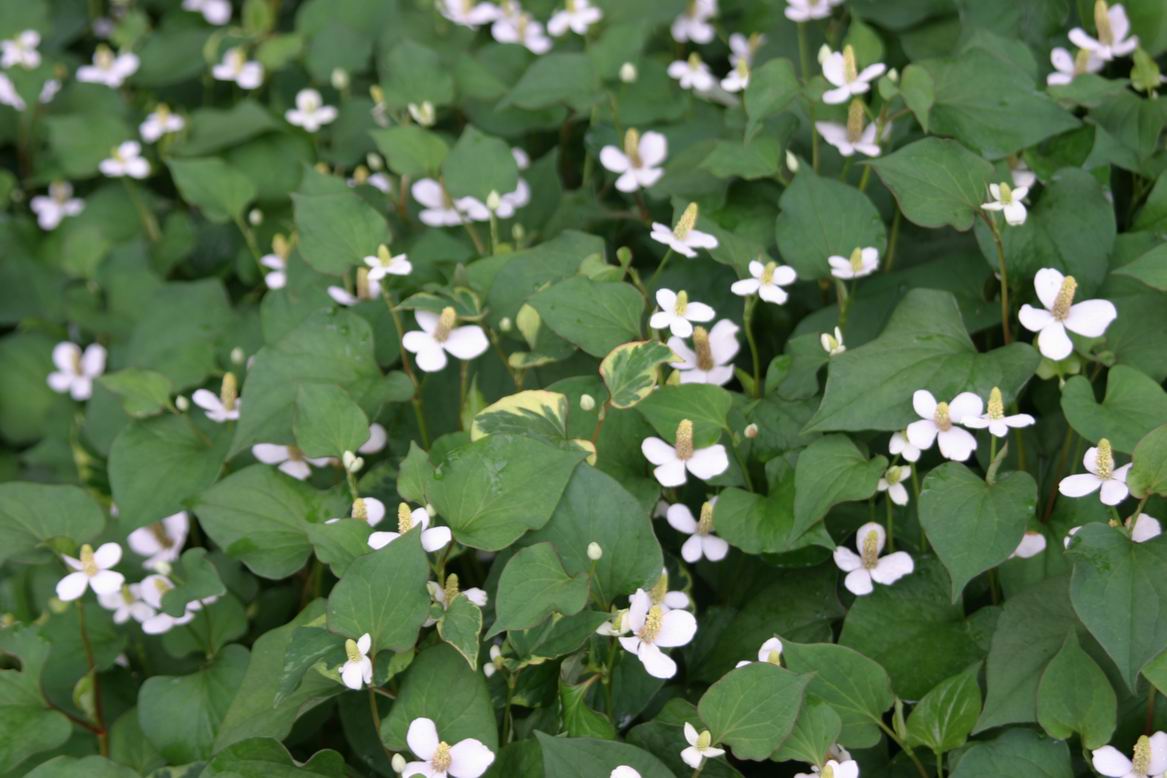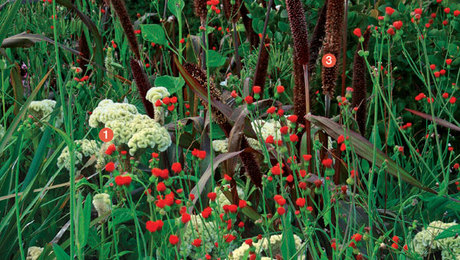
Photo/Illustration: Michelle Gervais
Here’s a gorgeous sweep of houttuynia at Cornell Plantations in Ithaca, New York. I fell in love with this plant then and there, and I think it’s beautiful, but every time we feature houttuynia (Houttuynia cordata and cvs., USDA Hardiness Zones 5-11) in the pages of the magazine, we get angry letters from readers who say this plant is evil. What’s your experience? Well-behaved groundcover, or Horrible Plague from Hell?

Photo/Illustration: Michelle Gervais
Welcome to the Fine Gardening GARDEN PHOTO OF THE DAY blog! Every weekday we post a new photo of a great garden, a spectacular plant, a stunning plant combination, or any number of other subjects. Think of it as your morning jolt of green.
Sign up to get new posts delivered to your inbox each morning so you’ll always remember to take a look, or subscribe to our RSS feed. We look forward to sharing our garden travels with you.
READER PHOTOS: We love featuring your photos, too. If you think you have a photo that we should share on the Garden Photo of the day, email us. Send hi-res images if possible. We’ll only respond if we plan to use your photo.
Fine Gardening Recommended Products

A.M. Leonard Deluxe Soil Knife & Leather Sheath Combo
Fine Gardening receives a commission for items purchased through links on this site, including Amazon Associates and other affiliate advertising programs.


















Comments
As you note, some of us consider it the Horrible Plague from Hell! In zone 9, it winds its way around and into the root area of treasured plants. So we dig and dig some more, yet it continues to pop up. Pity, it's so pretty.
evil? heck, not here. i love the yellow, green and red variegated variety( what a unique plant for that foliage color combo, and it also has a wonderful cinnamon scent)but it has never settled in here. I've never understood it but- in the areas of our arboretum where european ginger, japanese painted fern and maidenhair fern are all happily spreading, houttunyia is barely alive (after a number of years.) It has me believing that the happy threesome is dry soil- tolerant and houttunyia is definitely not.
best,
mindy
http://www.cottonarboretum.com/
Evil, definitely evil. It is simply uncontrollable, worse than just about any other plant.
Don't do it!
I admire this plant too, but tried unsuccessfully for years to grow it in the display gardens of my perennial and herb nursery, here is Zone 5. I gave it a pocket among the rocks bordering my little waterfall and pond; it looked nifty all season but died out every winter. So, not invasive for me, anyway. Now, you want to talk about violets?
This is a plant that is either loved or hated. I first saw it in WVa where a friend had combined it with impatients for a lovely summer border. I brought home to Pa a lovely shared plant, but it died out over the winter. I began a nursery search and finally located the plant. Mercy. I have pulled out, dug out, cut down, actually lost some gardening friends by sharing this devil weed. Pretty, yes. Ok in flower arrangements, but has a slight odor. Glad to share if anyone wants some.
Here in balmy Buffalo NY we have it growing in 2 locations. Containment has not been an issue as the soil is fairly dry in both areas. I think our growing zone also has a good deal to do with the lack of aggressiveness!
Out of interest, my Richters Herb Catalog lists Houttuynia cordata as Fish Mint, a Vietnamese herb called Vap Ca, with an "unusual, but interesting fish-like flavour" to be used on meat dishes and in soups.
Oh, "Horrible Plague from Hell" describes it well! Or perhaps that's only in South Carolina. Hate, hate, hate it! And it smells bad too.
Yes, Gardencoach, I would like to talk about violets! My mother had a big bed of white ones at the foot of our porch (in S.Dak.) and along the sidewalk. It looked a lot like the featured photo. Didn't seem to stray and was beautiful. I can barely get them to grow in Northern Virginia, but my brother-in-law yanks them as soon as he sees one!
EVIL, the devil in plant form... I made the mistake of planting it in a wet location in my garden and have spent years trying to dig and yank it out. Nothing works and I now have it everywhere. This year I will pay my daughter to sit for days and paint it with vegetation killer. Maybe that will work. NEVER use this plant where it can not be contained especially where the soil is poorly drained. Most aggressive and hard to get rid of plant I've ever dealt with in my 25yrs of gardening. Worse than Gooseneck Loosestrife. As pretty as it is, DON'T EVEN THINK ABOUT IT without containment.
Zone 6A, New Jersey
Live in Portland Or. and have it contained in one area, but must be dilligent as it will jump to the moon if the moon is well watered. Has ruined my son in law's beautiful garden in Seattle. Don't know how it spreads but it will jump from pot to pot also, and never use soil it has been planted in. The only way to kill it seems to be dry it out completely almost impossible in our part of the world. Looks beautiful just hate it.
When a gardening friend saw my new plantings of it she said it was invasive for her, also in zone 5, so I removed it. 2 years later (!!!) it popped up, got removed again + I haven't seen it since. Whew! I think the variegation is really pretty but it has to be "put in its place", which is a container or an area where it can go wild without invading anything you care about. Kinda reminds me of gooseneck loosestrife, in that regard. Violets are a nuisance, too, but let's not forget johnny jump-ups!
I think it's a lovely frangrance- spicy sweet citris and slightly vegetal-greem -- at least the variegated variety in my garden. I have it planted under a flowering shrub in dry shade clay, and there it has been well behaved. But when I bought it the nursery guru cautioned me, "oh beware!" I'm in zone 6, central Pennsylvania.
Zone 5-6, Michigan. Totally a plague--sends out runners in all directions; pops up uninvited yards away, under rocks, in the middle of perennials. Try to pull or dig it out and it breaks into pieces, each one of which will create a new plant. Unpleasantly scented as well. VERY pretty, especially where there is sun to bring out the variegation, but not worth it.
Good thing I didn't transplant the variegated variety from one of my containers into the garden as planned. I'm assuming we're too dry to make it happy, but it was sure pretty!
I have grown it in a garden in Zone 5 (Seattle)where it was planted next to a stream and waterfalls. It did spread, but not aggressively and I never saw it pop-up outside the area where I planted it. The variety I grew was multi-colored, however, so perhaps it is a more well-behaved cultivar.
I'm on the southern edge of zone 7. During the second year after planting the multi-colored variety I realized I was in for trouble, and tried to pull it out. Five years later, I'm still finding sprigs of it. It survived several years of drought, during which time I could only water by hand at restricted times. I thought it was lovely, but don't remember it flowering; and I wouldn't try it again - much too scary!
Zone 7B/8A, York Co., VA. I planted the variegated variety several years ago on a clay bank by a drainage ditch that usually has some water in it - looks more like a shallow creek - hoping it would spread and hold the bank. NO SUCH LUCK. There are a few sprigs here and there. Also managed to kill Bishop's Weed in a nearby area, so I don't know what the problem is.
mary md, you said "Seattle z. 5"?? you mean z.8 don't you?
Hey all,
So it looks like it was a good idea to pull this plant from our last issue, based on your comments! One of our GPOD readers, Barbara Littlefair, lives up near Cornell Plantations and decided to contact them to get their feedback on the plant. Here's what Mary Hirshfeld, Cornell Plantations' Director of Horticulture, had to say about this planting:
"The planting pictured was originally the multi-colored cultivar 'Chameleon' and what you see in the picture is an entirely reverted mass planting that became solid green. Because this plant is so tough, and that spot is very hot and dry, I chanced putting the Houttuynia there. However, because it is very difficult to get rid of, and spreads with dangerous velocity if not physically confined, I decided it was not a good idea to promote this plant. Our Plant Health staff were able to entirely eliminate this mass planting with two summertime applications of RoundUp applied one month apart, and I have replanted the area with a mixture of sedums and grasses. I would NEVER recommend this plant to anyone unless they were using it in a container, or as you describe with your sunken pot for mints, very carefully confined."
Thanks, Barbara and Mary!
Plant from hell! Still trying to make it disappear. Going on 4 years! I am a zone 5.
That plant is definely a plague here in Waterville Ohio. My neighbor offered me some to fill in a small bed near my house. I should have taken note that where he had it, it had grown underneath his cement patio and sprouted on the other side. The children said it smelled like fish. I have tried to eliminate it several times. Each summer I have to scout the area for any inevitable invaders. Chameleon is the culprit.
Beautiful but it chokes out everything else but the shrubs then dies back to dirt over the winter :( Mid-Atlantic zone 6B.
Log in or create an account to post a comment.
Sign up Log in